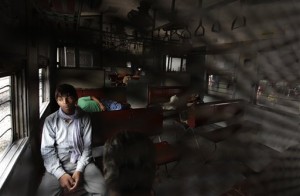Power cut blacks out 300 million in northern India

An Indian passenger sits as others sleep inside the compartment of a stationary train following the power outage that struck in the early hours of Monday, July 30, 2012, at a train station in New Delhi, India. A major power outage struck northern India, plunging cities into darkness and stranding hundreds of thousands of commuters. AP PHOTO/ALTAF QADRI
NEW DELHI—A massive power cut blacked out a vast swathe of northern India Monday, leaving an estimated 300 million people without power in the worst outage in more than a decade, officials said.
Power Minister Sushilkumar Shinde said the entire northern grid collapsed for six hours shortly after 2 a.m. (2030 GMT Sunday), causing chaos in nine states including the capital New Delhi.
The cut severely disrupted transport networks, including trains and metro services, while traffic light systems also went down in some major cities causing snarls in the morning rush hour.
Article continues after this advertisementArticle continues after this advertisement
Major hospitals and airports in the region were able to function normally on emergency back-up power, officials said.
“We are used to electricity going occasionally, so we have a good back-up system,” said a spokesman for Safdarjang Hospital in New Delhi, N. Makwana.
Shinde said a system overload was probably responsible for the outage. The grid was brought back online at 8 a.m., but running at only 60 percent capacity.
“It is an accident, a failure,” the minister admitted to reporters, adding that a special committee was being set up to probe the incident.
In a statement, the Power System Operation Corporation (PSOC), which manages the northern grid, said the “entire northern region,” which is home to 28 percent of India’s 1.2 billion population, had been affected.
The nine affected states were Delhi, Haryana, Himachal Pradesh, Jammu and Kashmir, Madhya Pradesh, Punjab, Rajasthan, Uttarakhand and Uttar Pradesh.
Limited power outages are extremely common across India, which runs a peak-hour power deficit of around 12 percent according to the Central Electricity Authority.
Industry leaders say electricity shortages have become a major obstacle to economic growth in the country, which has an installed power generation capacity of 187 gigawatts – about 20 percent of China’s level.
Shinde said the speed with which power had been restored to most areas compared well with similar mass outages in the developed world, including the 2003 blackout that affected much of the eastern seaboard of the United States.
“It took four days to restore power in America … our power grid is very good,” he said.
“By 2014, the whole country’s grids will be connected so they can take power from each other … so you won’t have these problems again,” he added.
In New Delhi, the city’s metro system shut down completely during the night and was operating only 25 percent of normal services from 7 a.m. (0130 GMT).
The last serious power outage in India was in 2001, when the northern grid crashed for around 12 hours, costing industry an estimated $110 million in lost production.
“I believe it (the outage) could be because of the great indiscipline of the states in overdrawing power – the grid will only collapse if you overdraw,” said Vivek Pandit, energy director at business lobby group the Federation of Indian Chambers of Commerce and Industry (FICCI).
India’s fast-growing economy is heavily dependent on highly pollutant coal and imports of crude oil. Less than three percent of India’s electricity comes from nuclear power but it hopes to raise the figure to 25 percent by 2050.